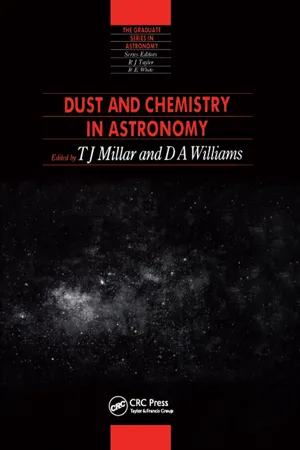![]()
1
Dust and astrochemistry: an introduction
T J Millar and D A Williams
1.1 THE PAST
It has long been recognized that dust is widespread in the Galaxy. The presence of dust is most obvious in dark clouds, in which dust absorbs and scatters the light of background stars so that the dust clouds are revealed by the apparent absence of such stars. Dust is, in fact, found to be generally distributed throughout interstellar space, and reveals itself through the extinguishing and reddening of starlight. The reddening occurs through selective extinction, in that blue light is more heavily extinguished than red. As far as the study of stars is concerned, dust is merely an irritating fog whose presence must be allowed for and which prevents the optical observation of very distant stars. However, it is now recognized that dust is a key component in our Galaxy, and presumably others. Without dust, the evolution of the Galaxy would have been very different, and the development of planetary systems such as our own would not have occurred. Interstellar dust interacts both with electromagnetic radiation and with the ambient gas. In this book we are particularly concerned with the dust–gas interaction.
The detection of ultraviolet absorption lines of molecular hydrogen in the interstellar medium by a rocket-borne experiment in 1970 ended a decade of speculation concerning the abundance of interstellar H2. This detection was followed a few years later by a survey conducted by the Orbiting Astronomical Observatory No. 3 (Copernicus) which confirmed indications from 21 cm surveys made in the 1950s that much of the interstellar matter was molecular in regions of modest visual extinction caused by interstellar dust. Such regions are called the diffuse interstellar clouds. Regions of higher visual extinction (optical depth around unity or larger) could not be studied in the same way, but they were found to contain a great variety of molecular species, detected through their radio spectra. Molecular hydrogen does not have a radio spectrum and cannot be detected in regions of low excitation. Nevertheless, H2 was expected to be abundant in such regions. The abundance of atomic hydrogen (detectable at 21 cm) does not continue to increase with increasing extinction, but tends to reach a maximum. If dust and gas are uniformly mixed, then a ready interpretation is that atomic hydrogen in dark clouds is converted to H2, consistent with the understanding that H2 is destroyed mainly by dissociative fluorescence. The direct detection of H2 was finally made at infrared wavelength in regions of dense clouds near to bright stars, where the level of excitation was sufficient to stimulate vibrational emission (Chapter 4).
The discussion concerning interstellar H2, even before its discovery, had confirmed that gas phase routes for forming H2 were unlikely to be very efficient under typical conditions in the interstellar medium (see Tables 1.1 and 1.2). Two such gas phase routes exist:
and
both of which have the very slow rate-limiting step of radiative association. Both involve a minor component, e or H+. Neither of these mechanisms could maintain the observed abundance of H2 in diffuse clouds, in which the radiation intensity is high and where the following steps
will, if v″ is in the vibrational continuum, destroy H2. The number densities, ~ 102 cm−3, are much too low for three-body collisions to play a role. By default, therefore, it became accepted that H2 was formed in some unspecified heterogeneous catalysis at the surface of interstellar dust grains. The observations required that a significant fraction of all H atoms colliding with a grain surface are incorporated into H2 molecules. The nature of this reaction is discussed in Chapter 7. The reaction is exothermic and the product H2 is almost certainly rovibrationally excited. This excitation may contribute to the observed rotational population of H2 in diffuse clouds (Chapter 8). Most attempts to understand the physics and chemistry of interstellar clouds have minimized the role of dust by confining surface chemistry to H2 formation, and describing, with varying degrees of success, the chemistry of interstellar clouds in terms of gas phase reactions. The nature of the dust on which H2 and other molecules may form is an important question, and one that has stimulated much lively discussion. Clearly, different surfaces may be expected to have different roles as chemically active substrates. Fortunately, there is now a considerable measure of agreement as to the nature of dust.
Table 1.1 Characteristic parameters of the various regions of interstellar space: Temperature, T(K); number density, n(m−3); atomic or molecular identifiers, i; fractional ionization, X; volume filling factor, fv; and mass fraction, fm.
Table 1.2 Features of the interstellar medium.
1.2 THE PRESENT
Although dust grains were accepted as being chemically active in terms of H2 formation, it has taken some time for their potential role in the chemistry of other species to be fully appreciated. It is the main purpose of this book to elucidate this role.
Table 1.3 Effects of interstellar dust particles.
Physical and chemical effect | Interpretation |
Visual extinction ∝ 1/λ | Solid particles, sizes ≈ λvis |
Visual polarization | Asymmetric particles partially aligned |
Nebulosity near stars | Scattering from dust |
Local extinction peak at 220 nm | Silicates, oxides or graphite |
Infrared bands (emission/absorption) | Hydrocarbons, silicates |
Infrared continuum emission | Re-emission of absorbed UV and visual |
Depletion of elements | Carbons, silicates, oxides |
Photoelectric effect | Hea... |


